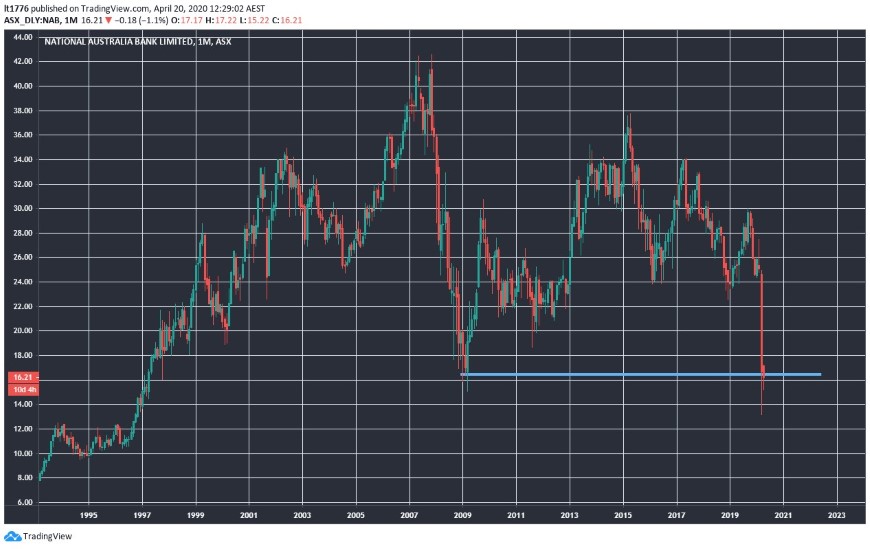The National Australia Bank Ltd [ASX:NAB] share price is down a little over 1% today at time of writing, and some may be wondering why it didn’t take a bigger dip.
The NAB share price took a steep fall at the onset of the coronavirus, and has traded sideways for around a month:
With the NAB share price finding support at a level not seen since the GFC, we look ahead to the potential for a capital raising, and maybe another leg down.
We have been writing for some time here at Money Morning about the perils the banking sector is currently facing (and the loss of dividends).
This morning should come as a warning to all shareholders of Australia’s banking sector — this banking bubble has been 126 years in the making.
The warning comes as NAB announced that first-half earnings will take a $1.14 billion after-tax hit.
NAB shares were trading down six cents at $16.33 after an hour of trading this morning and are down 36% over the last three months.
While it would certainly be disappointing news to shareholders, considering the beating the banks have taken over the past couple of years, sometimes this is just the cost of doing business.
NAB flagged additional remediation costs for the fee-for-no-service scandal, a reduction in the value of its MLC wealth business, and additional software expenses, which all contributed to the profit hit.
In many ways, we’ve seen this coming for some time — and the pain is priced in.
If it’s in the headlines it’s already in the price.
What should worry shareholders is that these costs do not account for the full economic impact of the coronavirus.
Hayne set them up, coronavirus bowls them down
It’s easy to be critical of the banks.
The Royal Banking Commission uncovered some dastardly deeds committed by Australia’s largest financial institutions.
Westpac Banking Corporation [ASX:WBC]’s transgressions spring to mind as the most egregious.
So, we knew there are going to be ongoing costs associated with compensating those who the banks have wronged.
What no one was looking out for was an economic downturn.
NAB said the remediation sum of $268 million before tax is expected to reduce its common equity tier 1 capital (CET1) ratio by six basis points.
At its quarterly result in February, NAB said its CET1 ratio was 10.6%.
This is just above the ‘unquestionably strong’ requirement, which the banks are now allowed to drift below in order to support new lending into the struggling economy.
Analysts are expecting a half-year profit of just over $3 billion, and $6 billion for the full-year.
This means the additional charges announced today represent about 36% of the expected first-half earnings and 18% of the full-year profit.
COVID-19 is likely to trigger higher credit impairment charges across the banking sector as unemployment rises and housing credit growth slows.
Such a scenario could see the bank’s CET1 ratio pushed lower.
Westpac last Tuesday was forced to shave 30 basis points off its CET1, leaving the bank sitting on a 10.5% ratio (right on the unquestionably strong benchmark set by APRA).
WBC announced last week it would take a $1.43 billion hit to profits.
From cash cow to cash hungry
The AFR notes that there is speculation in the market that NAB could announce a capital raising at its interim results on May 7 to strengthen its balance sheet.
While slashing its dividend would achieve the same result, asking shareholders for cash could mark a turning point for ASX bank stocks in Australia.
If you’re looking for help dealing with the financial implications of COVID-19, check out ‘The Coronavirus Portfolio’.
We’ve constructed a two-pronged plan that could help you benefit if the crisis worsens. And prepare you for the big changes in the world of finance that are to come.
Download your free report here.
Regards,
Lachlann Tierney,
For Money Morning



Comments